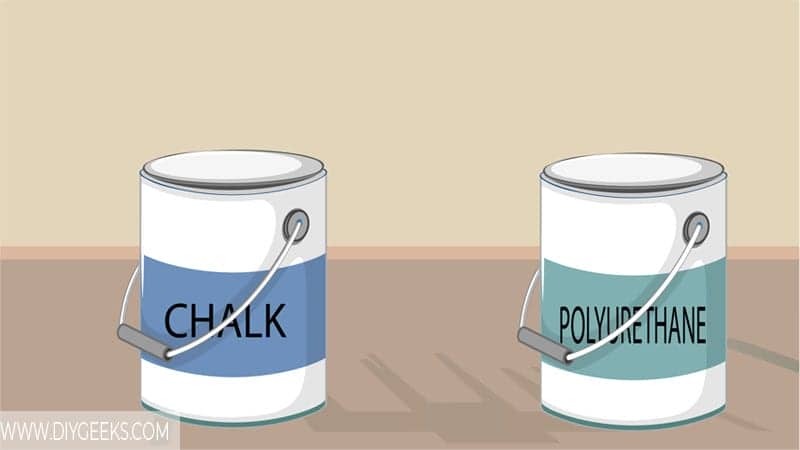You can apply polyurethane over chalk paint to protect it from moisture, water, scratches, and other damage. Polyurethane forms a glossy layer over the finish and shields it from different elements.
To apply polyurethane over chalk paint, clean the surface, sand the surface, and apply polyurethane.
For outdoor chalk paint surfaces use oil-based or exterior polyurethane, and for indoor surfaces use water-based polyurethane.
What Types of Polyurethane Can You Use Over Chalk Paint?
You can use three types of polyurethane: oil-based & exterior polyurethane and, water-based polyurethane over chalk paint.
1. Oil-Based & Exterior Polyurethane
Use oil-based or exterior polyurethane over outdoor chalk paint surfaces as they are more durable and can withstand outdoor weather better.
Applying them is harder because they have a thicker flow, take longer to dry, and their finish tends to yellow over thin.
In addition, you must thin oil-based polyurethane before applying it.
2. Water-based Polyurethane
Use water-based polyurethane for indoor chalk paint surfaces as it dries faster, is easier to apply, doesn’t yellow over time, and you don’t need to thin it.
How Long Must Chalk Paint Dry Before Applying Polyurethane?
Chalk paint must fully dry (cure) for 24 hours before applying polyurethane. Chalk paint takes 30 minutes to dry enough for a re-coat, but the paint must fully dry (cure) for 24 hours before you can seal it.
The exact dry time depends on the room temperature, humidity levels, thickness and number of the coats. You can speed up the drying time by increasing the air circulation and improving the evaporation rate.
Once the paint fully dries (cures) the paint particles harden and become compact enough to support a sealer. The finish will turn sticky and the sealer won’t dry if you seal it too soon.
How To Apply Polyurethane Over Chalk Paint?
To apply polyurethane over chalk paint, do the following things.
- Clean the Finish.
- Sand the Finish.
- Apply Polyurethane.
1. Clean the Finish
Clean the finish to remove stains, dirt, dust, and imperfections from it. The finish must be clean without imperfections because polyurethane is a clear coat (colorless) finish and will highlight imperfections.
To clean chalk paint before polyurethane, do the following things.
- Mix soap with warm water.
- Apply the mixture over chalk paint.
- Use a soft brush or clean rag to scrub the dirt or stains off.
- Remove the soapy water residue from the surface using clean water.
Wait until the finish fully dries (cures) before cleaning it. If you clean it too soon, you will remove the paint.
If there aren’t stains or dirt over the finish, use a clean rag (without water) to clean and remove dust only.
Related Read: Will Polyurethane Stick to Tacky Stain?
2. Sand the Finish
Sanding the finish is optional as polyurethane will stick over it regardless. However, sanding will remove bumps and imperfections and leave a smooth and even surface behind for the sealer to stick.
To sand chalk paint, use fine-grit sandpaper (220-grit). Don’t use coarse-grit sandpaper as it can remove the entire finish.
After sanding, remove the dust.
3. Apply Polyurethane
Once the chalk paint is clean, sanded, and dry, apply 3 coats of polyurethane over it. To apply it, use a paintbrush, roller, or sprayer. If you use a sprayer, you must thin it. Wait until the previous coat dries before applying the next one.
Optionally, you can sand between coats of the sealer (except for the final coat).
Polyurethane vs. Wax (For Chalk Paint)
Polyurethane is easier to apply and maintain on chalk pants than wax. Wax will give the finish a darker shade, while polyurethane won’t change the color shade of the finish.
For high-traffic surfaces, polyurethane is better than wax. That’s because the wax is a low-durability finish that can’t withstand high use. If the wax finish gets damaged, you must re-apply the wax to fix it. And, re-applying wax over the paint is hard because you must remove most of the wax.
On the other hand, polyurethane is a durable finish that will last for 5-10 years and won’t get damaged easily. Also, if the coating does gets damaged, all you need to do is sand it and re-apply it.
Can You Mix Chalk Paint With Polyurethane?
You can mix chalk paint with water-based polyurethane, but you can’t mix it with oil-based polyurethane. Chalk paint uses water as its solvent and doesn’t mix with oils.
The water-based polyurethane and chalk paint mixture will produce a colorful and durable finish. Since polyurethane has no color (no pigments) mixing it with another paint will give its finish a color.
If you mix water-based paints with oil-based polyurethane the mixture won’t stick, dry, and will peel off.


